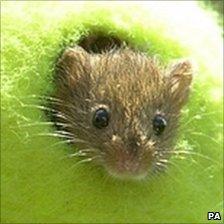Experts fear extinction for Britain's harvest mouse
- Published

Harvest mice numbers have plummeted as habitats are destroyed
A historical emblem of the British countryside could become extinct in the UK within 25 years, farmers' group Conservation Grade has warned.
The harvest mouse is among 10 species that experts from a sustainability project fear could disappear by 2035.
Numbers of the tiny mammal, which lives in hedgerows and fields, have plummeted due to changes in farming methods.
Other species on the danger list include the once-common grey partridge, the tree sparrow and the corn marigold.
The gloomy predictions come on the eve of the Nagoya conference in Japan, where delegates will seek to set global policy on halting and reversing loss of biodiversity.
Habitats destroyed
The warning comes from Conservation Grade - a group of ecologically minded farmers.
Tim Nevard, of Conservation Grade, said: "Many species that we remember from childhood have become increasingly rare in the UK due to intensive farming methods.
"We need to feed the growing population - that is an absolute priority, but we also need to produce food in a way that doesn't strip our planet bare of its biodiversity. Nagoya is the world's last chance to start the change."
Harvest mice build spectacular ball-like nests in hedgerows and field edges.
But as their habitats have been destroyed, numbers have fallen dramatically - and now the mouse has been added to the at-risk species red list.
Mr Nevard warned that a bleak vision of a countryside stripped of wildlife, as imagined in Rachel Carson's seminal 1962 environmental text Silent Spring, could become reality if action was not taken.
"The image most people have of the countryside is one rich with wild flowers, farmland birds and butterflies.
"But that picture has changed dramatically over the last forty years and although we have largely removed the threat of dangerous pesticides identified by Rachel Carson, we are rapidly heading towards her Silent Spring unless we do something radical."